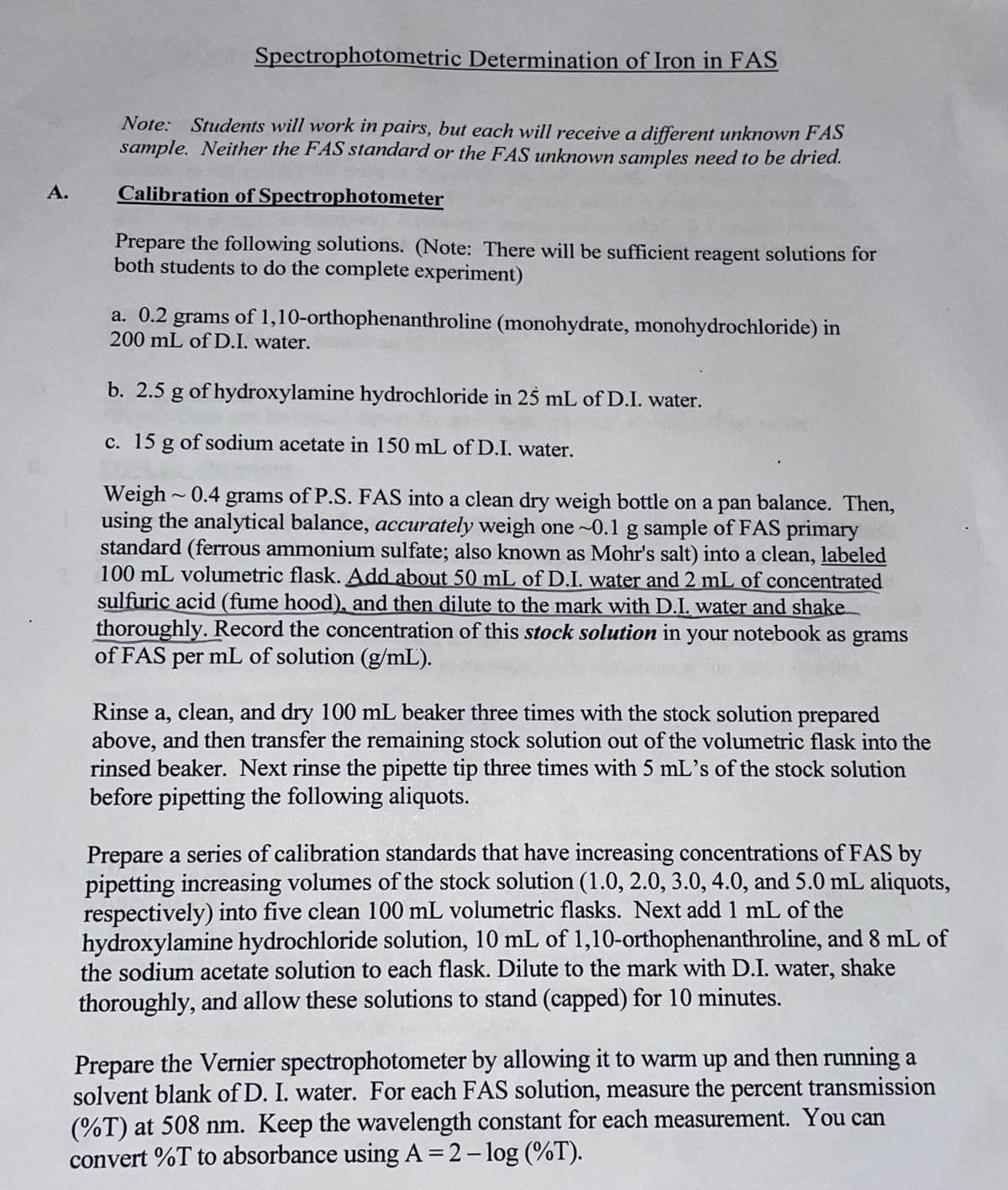Why is it necessary to buffer the solution with sodium acetate in the spectrophotometic determination of iron in FAS (ferrous ammonium sulfate or Mohr's salt)? Be specific.
Why is it necessary to buffer the solution with sodium acetate in the spectrophotometic determination of iron in FAS (ferrous ammonium sulfate or Mohr's salt)? Be specific.
Chapter24: Introduction To Spectrochemical Methods
Section: Chapter Questions
Problem 24.28QAP
Related questions
Question
Why is it necessary to buffer the solution with sodium acetate in the spectrophotometic determination of iron in FAS (ferrous ammonium sulfate or Mohr's salt)? Be specific.

Transcribed Image Text:Spectrophotometric Determination of Iron in FAS
Note: Students will work in pairs, but each will receive a different unknown FAS
sample. Neither the FAS standard or the FAS unknown samples need to be dried.
А.
Calibration of Spectrophotometer
Prepare the following solutions. (Note: There will be sufficient reagent solutions for
both students to do the complete experiment)
a. 0.2 grams of 1,10-orthophenanthroline (monohydrate, monohydrochloride) in
200 mL of D.I. water.
b. 2.5 g of hydroxylamine hydrochloride in 25 mL of D.I. water.
c. 15 g of sodium acetate in 150 mL of D.I. water.
Weigh ~ 0.4 grams of P.S. FAS into a clean dry weigh bottle on a pan balance. Then,
using the analytical balance, accurately weigh one ~0.1 g sample of FAS primary
standard (ferrous ammonium sulfate; also known as Mohr's salt) into a clean, labeled
100 mL volumetric flask. Add about 50 mL of D.I. water and 2 mL of concentrated
sulfuric acid (fume hood), and then dilute to the mark with D.I. water and shake
thoroughly. Record the concentration of this stock solution in your notebook as grams
of FAS
per mL of solution (g/mL).
Rinse a, clean, and dry 100 mL beaker three times with the stock solution prepared
above, and then transfer the remaining stock solution out of the volumetric flask into the
rinsed beaker. Next rinse the pipette tip three times with 5 mL's of the stock solution
before pipetting the following aliquots.
Prepare a series of calibration standards that have increasing concentrations of FAS by
pipetting increasing volumes of the stock solution (1.0, 2.0, 3.0, 4.0, and 5.0 mL aliquots,
respectively) into five clean 100 mL volumetric flasks. Next add 1 mL of the
hydroxylamine hydrochloride solution, 10 mL of 1,10-orthophenanthroline, and 8 mL of
the sodium acetate solution to each flask. Dilute to the mark with D.I. water, shake
thoroughly, and allow these solutions to stand (capped) for 10 minutes.
Prepare the Vernier spectrophotometer by allowing it to warm up and then running a
solvent blank of D. I. water. For each FAS solution, measure the percent transmission
(%T) at 508 nm. Keep the wavelength constant for each measurement. You can
convert %T to absorbance using A=2- log (%T).
%3D
Expert Solution
This question has been solved!
Explore an expertly crafted, step-by-step solution for a thorough understanding of key concepts.
This is a popular solution!
Trending now
This is a popular solution!
Step by step
Solved in 2 steps

Knowledge Booster
Learn more about
Need a deep-dive on the concept behind this application? Look no further. Learn more about this topic, chemistry and related others by exploring similar questions and additional content below.Recommended textbooks for you



Principles of Instrumental Analysis
Chemistry
ISBN:
9781305577213
Author:
Douglas A. Skoog, F. James Holler, Stanley R. Crouch
Publisher:
Cengage Learning



Principles of Instrumental Analysis
Chemistry
ISBN:
9781305577213
Author:
Douglas A. Skoog, F. James Holler, Stanley R. Crouch
Publisher:
Cengage Learning